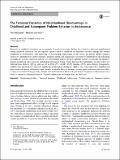Files in this item
The temporal dynamics of neighborhood disadvantage in childhood and subsequent problem behavior in adolescence
Item metadata
| dc.contributor.author | Kleinepier, Tom | |
| dc.contributor.author | van Ham, Maarten | |
| dc.date.accessioned | 2018-07-12T10:30:09Z | |
| dc.date.available | 2018-07-12T10:30:09Z | |
| dc.date.issued | 2018-06-30 | |
| dc.identifier | 253198271 | |
| dc.identifier | 963bf57c-44ed-4b32-a845-2243976ee455 | |
| dc.identifier | 85049216159 | |
| dc.identifier | 000438686700004 | |
| dc.identifier.citation | Kleinepier , T & van Ham , M 2018 , ' The temporal dynamics of neighborhood disadvantage in childhood and subsequent problem behavior in adolescence ' , Journal of Youth and Adolescence , vol. First Online . https://doi.org/10.1007/s10964-018-0878-6 | en |
| dc.identifier.issn | 0047-2891 | |
| dc.identifier.other | ORCID: /0000-0002-2106-0702/work/64697483 | |
| dc.identifier.uri | https://hdl.handle.net/10023/15298 | |
| dc.description | The research leading to these results has received funding from the European Research Council under the European Union's Seventh Framework Programme (FP/2007-2013) / ERC Grant Agreement n. 615159 (ERC Consolidator Grant DEPRIVEDHOODS, Socio-spatial inequality, deprived neighbourhoods, and neighbourhood effects). | en |
| dc.description.abstract | Research on neighborhood effects has increasingly focused on how long children have lived in a deprived neighborhood during childhood (duration), but has typically ignored when in childhood the exposure occurred (timing) and whether neighborhood circumstances were improving or deteriorating (sequencing). In this article, the authors applied sequence analysis to simultaneously capture children’s duration, timing, and sequencing of exposure to neighborhood (dis)advantage in childhood. Logistic regression analysis was subsequently used to test how different patterns of exposure are related to teenage parenthood, school dropout, and delinquent behavior. Using register data from the Netherlands, an entire cohort was followed from birth in 1995 up until age 19 in 2014 (N = 168,645, 48.8% females, 83.2% native Dutch). Compared to children who had lived in a deprived neighborhood throughout childhood, children who were exposed to neighborhood deprivation only during adolescence were found to be equally likely to become a teenage parent and were even more likely to drop out of school. Unexpectedly, children who had lived in an affluent neighborhood throughout childhood were most likely to engage in delinquent behavior. Possible explanations and implications are discussed. | |
| dc.format.extent | 18 | |
| dc.format.extent | 1207747 | |
| dc.language.iso | eng | |
| dc.relation.ispartof | Journal of Youth and Adolescence | en |
| dc.subject | Neighbourhood effects | en |
| dc.subject | Temporal dynamics | en |
| dc.subject | Childhood | en |
| dc.subject | Adolescence | en |
| dc.subject | Problem behavior | en |
| dc.subject | Sequence analysis | en |
| dc.subject | GF Human ecology. Anthropogeography | en |
| dc.subject | HT Communities. Classes. Races | en |
| dc.subject | HN Social history and conditions. Social problems. Social reform | en |
| dc.subject | 3rd-DAS | en |
| dc.subject.lcc | GF | en |
| dc.subject.lcc | HT | en |
| dc.subject.lcc | HN | en |
| dc.title | The temporal dynamics of neighborhood disadvantage in childhood and subsequent problem behavior in adolescence | en |
| dc.type | Journal article | en |
| dc.contributor.sponsor | European Research Council | en |
| dc.contributor.institution | University of St Andrews. School of Geography & Sustainable Development | en |
| dc.identifier.doi | 10.1007/s10964-018-0878-6 | |
| dc.description.status | Peer reviewed | en |
| dc.date.embargoedUntil | 2018-06-30 | |
| dc.identifier.grantnumber | ERC-2013-CoG | en |
This item appears in the following Collection(s)
Items in the St Andrews Research Repository are protected by copyright, with all rights reserved, unless otherwise indicated.

